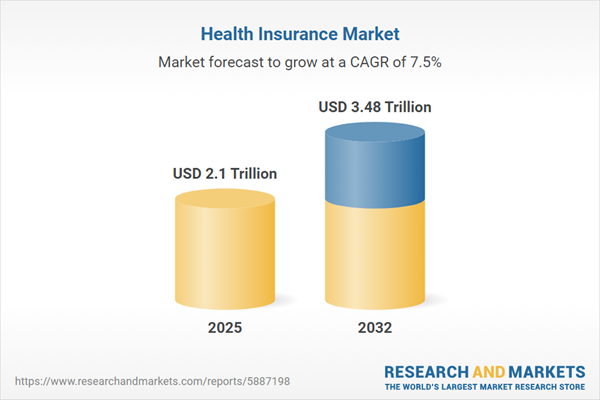Speak directly to the analyst to clarify any post sales queries you may have.
The health insurance market is evolving rapidly as new technologies, shifting regulations, and changing consumer expectations drive complex decision-making for industry leaders. This report equips senior executives with a concise overview of the sector’s competitive landscape, innovation levers, and future risk factors, enabling informed, strategic planning.
Market Snapshot: Health Insurance Market Size and Growth
The health insurance market expanded from USD 1.95 trillion in 2024 to USD 2.10 trillion in 2025. Anticipated to maintain a robust trajectory, the sector is projected to reach USD 3.48 trillion by 2032, reflecting a CAGR of 7.48%. This growth is underpinned by rising adoption of digital health technologies, regulatory reforms, and consumer demand for comprehensive, flexible coverage across global regions.
Scope & Segmentation of the Health Insurance Market
The report offers a granular analysis of the health insurance market, investigating operational, technological, and strategic differentiation across regions and customer profiles. Segments analyzed include:
- Plan Types: Exclusive Provider Organizations (EPO), Health Maintenance Organizations (HMO), Point of Service (POS), Preferred Provider Organizations (PPO)
- Distribution Channels: Bancassurance, Broker, Direct Sales, Online
- Coverage Types: Dental, Medical, Supplemental (Accident, Critical Illness, Hospital Cash), Vision
- Customer Types: Family, Group (Large Group, Small Group), Individual
- Regions: Americas (United States, Canada, Mexico, Brazil, Argentina, Chile, Colombia, Peru), Europe, Middle East & Africa (United Kingdom, Germany, France, Russia, Italy, Spain, Netherlands, Sweden, Poland, Switzerland, United Arab Emirates, Saudi Arabia, Qatar, Turkey, Israel, South Africa, Nigeria, Egypt, Kenya), Asia-Pacific (China, India, Japan, Australia, South Korea, Indonesia, Thailand, Malaysia, Singapore, Taiwan)
- Leading Companies: UnitedHealth Group Incorporated, Elevance Health, Inc., CVS Health Corporation, Cigna Corporation, Humana Inc., Centene Corporation, Health Care Service Corporation, Kaiser Foundation Health Plan, Inc., Molina Healthcare, Inc., Highmark Health
Key Takeaways for Senior Decision-Makers
- The health insurance market is being reshaped by advances in artificial intelligence, enabling payers to optimize claims management and personalize member outreach.
- Emerging distribution channels, including digital and bancassurance, are improving access and lowering acquisition costs, while supporting retention strategies that drive long-term growth.
- Segmented coverage strategies—such as supplemental benefits and wellness incentives—are becoming central to member retention and risk mitigation, especially across family and employer groups.
- Providers and insurers are increasingly collaborating on value-based models and shared incentive frameworks, supporting integrated care coordination and cost management.
- Geographic differences in regulatory environments and consumer behaviors require tailored product portfolios, emphasizing regional compliance and local healthcare partnerships.
Tariff Impact: Costs, Networks, and Member Access in 2025
The introduction of U.S. tariffs in 2025 increased the cost of imported medical supplies and pharmaceuticals, resulting in higher expenses for providers and carriers. These pressures are seen in contract renegotiations, premium adjustments, and the pursuit of alternative sourcing to reduce exposure. Network adequacy and member affordability remain priorities, with some firms turning to automation and domestic supply chains. Regulatory bodies are considering targeted interventions to support members during this adjustment period.
Methodology & Data Sources
This report integrates primary interviews with senior executives and risk managers, alongside analysis of regulatory filings, industry publications, and financial disclosures. Segmentation uses cluster analysis and cross-tabulation to assess plan performance and channel dynamics. All findings are triangulated for accuracy.
Why This Report Matters
- Enables strategic planning by providing actionable insights on technology, regulatory trends, and regional segment opportunities.
- Guides resource allocation across plan types, provider partnerships, and digital channels to enhance operational efficiency and member satisfaction.
Conclusion
Health insurance industry leaders face a dynamic landscape shaped by innovation, regulation, and evolving member needs. This report provides actionable clarity for shaping differentiated strategies, mitigating risks, and pursuing sustainable competitive advantage.
Additional Product Information:
- Purchase of this report includes 1 year online access with quarterly updates.
- This report can be updated on request. Please contact our Customer Experience team using the Ask a Question widget on our website.
Table of Contents
3. Executive Summary
4. Market Overview
7. Cumulative Impact of Artificial Intelligence 2025
Companies Mentioned
The companies profiled in this Health Insurance market report include:- UnitedHealth Group Incorporated
- Elevance Health, Inc.
- CVS Health Corporation
- Cigna Corporation
- Humana Inc.
- Centene Corporation
- Health Care Service Corporation
- Kaiser Foundation Health Plan, Inc.
- Molina Healthcare, Inc.
- Highmark Health
Table Information
| Report Attribute | Details |
|---|---|
| No. of Pages | 191 |
| Published | October 2025 |
| Forecast Period | 2025 - 2032 |
| Estimated Market Value ( USD | $ 2.1 Trillion |
| Forecasted Market Value ( USD | $ 3.48 Trillion |
| Compound Annual Growth Rate | 7.4% |
| Regions Covered | Global |
| No. of Companies Mentioned | 11 |









